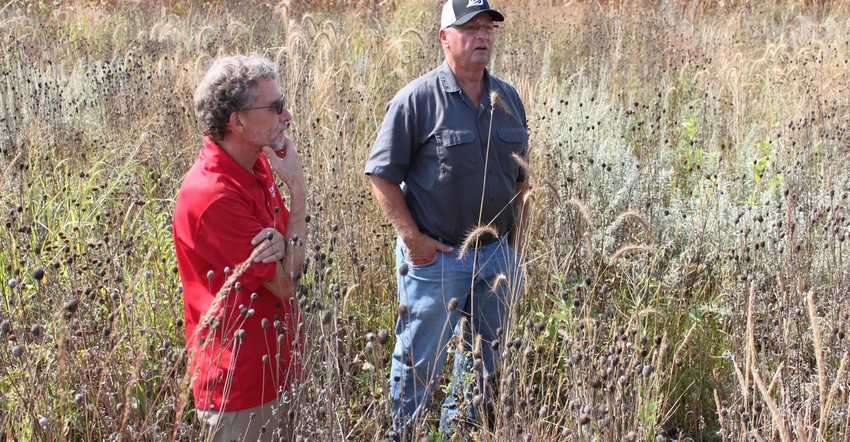May 23, 2018

By Willy Klein
Farming near Osage in northeast Iowa, this year marks the 45th crop Wayne Fredericks has planted on the 750 acres he farms using no-till, strip till and cover crops. While he’s hopeful for great soybean and corn crops, he is especially proud of the 7 acres of pollinator habitat that are sprinkled around his Mitchell County farm operation.
Fredericks has seven pollinator habitat locations on his farm, the first five planted in 2014 after he heard a presentation at an Iowa Soybean Association meeting before he became involved in the national effort to conserve the monarch butterfly. “The presenter encouraged us to overlay yield data and profitability on our land, which proved that some land would be more profitable in CRP than crops,” says Fredericks, a former president of ISA. “I immediately found five areas where pollinator habitat would be a better fit than crops.”
A 0.75-acre triangle near his farm site that big equipment just didn’t fit into and a 3-acre piece surrounding a sink hole in the corner of a field were both squared off and pollinator habitat planted. He seeded a small area by a hoop building that he had tried unsuccessfully to crop, and added a habitat planting when he installed a bioreactor in 2016.
During those years, the plight of the monarch gained attention and Fredericks got onboard to help.
Monarch population down dramatically
According to the National Fish and Wildlife Foundation, over the past 20 years, the monarch population has fallen by over 80%, mostly due to loss of critical breeding habitat. Iowa is in the middle of the breeding range and one of the areas with the largest losses of habitat.
In 2015, Iowa State University and 20 organizations started the Iowa Monarch Conservation Consortium to help restore monarch habitat and increase their population. The consortium now includes more than 40 organizations and agencies each bringing perspectives of their members to the discussion about how the needs of farmers and monarchs can best co-exist.
“It’s important to see commodity groups and conservation partners at the table because they bring different ideas and perspectives on how to help the monarch,” says Susan Kozak, a consortium representative for the Iowa Department of Agriculture and Land Stewardship. “Each group has the respect of its membership and good communication channels, which helps the consortium build awareness of the urgency and share the relevant research.”
More butterfly habitat acres needed
The sense of urgency comes with the impending decision on whether the monarch will be determined to be a threatened species by the U.S. Fish and Wildlife Service. It is a determination that will be made by June 2019 and could result in significant regulatory and management burdens for farmers, livestock producers and other private landowners.
“This is an all-hands-on-deck effort,” says Karen Kinkead, consortium representative from Iowa Department of Natural Resources and Iowa’s representative to the regional monarch conservation group. “Everyone is critical; everyone needs to help out. Monarchs are an unusual species in that anyone whether they have acres or a small garden space to put into habitat, can make a difference.”
Kinkead says the Iowa Monarch Conservation Consortium is connecting ag and conservation groups, and interested community groups with university research to meet recently announced goals of establishing 280,000 to 430,000 acres of monarch habitat over the next 20 years. She says state plans are where the work gets done, and Iowa is viewed as a leader.
Farmers adding pollinator habitat
Across Iowa, farmers like Wayne Fredericks are adding habitat plantings to low-productivity spaces and into CRP acres. Pork producers are planting pollinator habitat around livestock buildings. Pheasants Forever and Quail Forever are including milkweed in their grassland seed mixes showing how monarch and quail habitat have significant overlap.
Iowa’s ethanol and biodiesel plants began adding monarch butterfly habitats on green spaces surrounding their plants this spring. Des Moines Blank Park Zoo is promoting the “Plant.Grow.Fly.” program to homeowners who have space for prairie gardens.
Iowa State University recently received funding from the USDA National Institute of Food and Agriculture for research that will support the development of additional practical, science-based strategies for increasing monarch butterfly habitat in combination with crop and livestock production in Iowa and the Upper Midwest. The project will determine how pesticides used in crop fields may influence monarch survival and the reproduction in habitat located near field borders. The research may open more areas in Iowa where habitat can be located.
Learn how to be involved
The Farm Progress Show comes to Iowa on Aug. 28-30. Iowa State University is including the Iowa Monarch Conservation Consortium in the ISU exhibit building at the corner of Central Avenue and Seventh Street. It will be a chance for visitors to talk to researchers, get questions answered, pick up the monarch seed mix list, and get a butterfly’s perspective of the lay of the land.
Klein is a communication specialist with Iowa State University Extension and Outreach.
How habitat benefits farmers
Seth Appelgate, an agronomist on Iowa State University’s monarch research team, says there are many benefits to farmers who plant pollinator habitat. They include the following:
• It beautifies the landscape and over time reduces time spent mowing grass.
• Monarch habitat is one of the best environments for quail and pheasants.
• It benefits other pollinators like the rusty patched bumblebee, which was recently added to the Endangered Species list.
• Adding pollinator habitat may improve chances of re-enrollment in the Conservation Reserve Program.
• Demonstrating proactive and voluntary work to enhance monarch butterfly habitat could help avoid additional government oversight and regulations in the future.
You May Also Like




